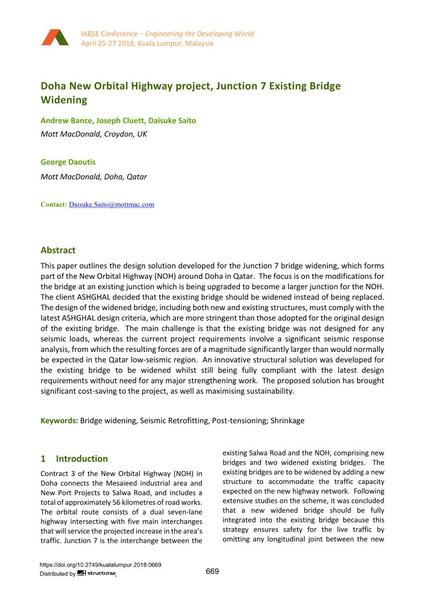Doha New Orbital Highway project, Junction 7 Existing Bridge Widening

|
|
|||||||||||
Bibliographic Details
| Author(s): |
Andrew Bance
(Mott MacDonald, Croydon, UK)
Joseph Cluett (Mott MacDonald, Croydon, UK) Daisuke Saito (Mott MacDonald, Croydon, UK) George Daoutis (Mott MacDonald, Doha, Qatar) |
||||
|---|---|---|---|---|---|
| Medium: | conference paper | ||||
| Language(s): | English | ||||
| Conference: | IABSE Conference: Engineering the Developing World, Kuala Lumpur, Malaysia, 25-27 April 2018 | ||||
| Published in: | IABSE Conference Kuala Lumpur 2018 | ||||
|
|||||
| Page(s): | 669-676 | ||||
| Total no. of pages: | 8 | ||||
| DOI: | 10.2749/kualalumpur.2018.0669 | ||||
| Abstract: |
This paper outlines the design solution developed for the Junction 7 bridge widening, which forms part of the New Orbital Highway (NOH) around Doha in Qatar. The focus is on the modifications for the bridge at an existing junction which is being upgraded to become a larger junction for the NOH. The client ASHGHAL decided that the existing bridge should be widened instead of being replaced. The design of the widened bridge, including both new and existing structures, must comply with the latest ASHGHAL design criteria, which are more stringent than those adopted for the original design of the existing bridge. The main challenge is that the existing bridge was not designed for any seismic loads, whereas the current project requirements involve a significant seismic response analysis, from which the resulting forces are of a magnitude significantly larger than would normally be expected in the Qatar low-seismic region. An innovative structural solution was developed for the existing bridge to be widened whilst still being fully compliant with the latest design requirements without need for any major strengthening work. The proposed solution has brought significant cost-saving to the project, as well as maximising sustainability. |
||||
| Keywords: |
bridge widening seismic retrofitting post-tensioning shrinkage
|
||||
